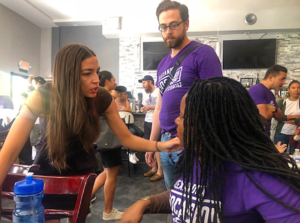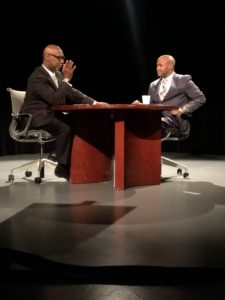Loud cheering erupted as Alexandria Ocasio-Cortez walked through the doors of Lorraine’s Restaurant in Parkchester for her congressional campaign kick-off rally last September. The come-from-behind candidate went out of her way to stop and thank each of her supporters throughout the room, in the neighborhood where she has deep roots.
Her campaign had already become as much a national resistance movement to the dominant two-party rule as it is a full-throated embrace of issues that matter deeply to communities of color. “This is not just about winning elections it is about advancing a movement,” Ocasio shouted to supporters
“There are a lot of folks that are in other districts who are a little scared to say things like, ‘Black Lives Matter,” she told the crowd of more than a hundred supporters. “That’s fine, but we have the opportunity to say those things. And when we have it, we must.”
Faces of all different colors filled the restaurant. Males and females, young and old.
She was as stunned as the rest of mid-term primary election watchers last June when she wrested the Democratic Party’s nomination for U.S. Congress from ten-term incumbent Joe Crowley. At 28-years-old, Ocasio is everything her primary opponent was not: a community organizer, brand new to campaigning, she is a proud, socialist Latina. Her platform reflects her roots.
Ocasio came into the 14th Congressional District primary race with no established network in politics, yet she draws fired-up crowds. Nearly 200 enthusiasts packed into Lorraine’s restaurant that September night.
Nearly 65 percent of Ocasio’s campaign contributions came from individuals who gave less than $200 each. In contrast, her opponent, Republican Anthony Pappas, received the majority of his contribution from large corporations.
Her campaign was built from coalition of groups that politicians rarely reach out to, such as Black Lives Matter of Greater New York and the Kalief Browder Foundation for criminal justice reforms. This clear focus on issues Latino and black communities care about lead many in the black community to predict Ocasio has what it takes to appeal to the black vote in November.
“We need a vocal and active resister to the Trump agenda,” said Kirsten John Foy, political strategist for Al Sharpton’s National Action Network. Foy said Ocasio’s opposition to the real estate interests is critical to the black community. “Black people are suffering at the hands of forces of gentrification as well as being victims,” he said.
Rolling out her revolutionary platform, Ocasio has not missed a beat. In three separate events in the Bronx in September, Ocasio emphasized three key issues: criminal justice reform, Medicare for all, and eliminating the federal Immigration and Customs Enforcement agency.
Each of these issues directly relate to communities of color. Black community members hope her focus on this issues are enough to gain trust and the full support of the black voters, who have become increasingly disengaged from the voting booth.
“Her relatable story to people of color will bring us out on election day,” said Joyce Hounkanran, an African-American supporter.

Ocasio connecting with potential constituents at a fall campaign rally in Lorraine’s Restaurant, Parkchester. Photo credit: Olivia Eubanks
Her appeal to Latino voters is nearly automatic as Latinos are excited to have a Puerto Rican running and she is working hard to energize black voters as well, a group that has grown less likely to vote in recent trends.
The Democratic black vote declined by 2 percent between the 2012 presidential election when Barack Obama was the Democratic nominee, to 2016 when Hillary Clinton ran. Civil Rights activist and leading voice in the Black Lives Matter movement, DeRay Mckesson, said black people are skeptical about voting for politicians who say they will change black communities, and then never do it.
He believes Ocasio may be able to bring the black vote out because of her authenticity and relatable life. “Unlike most politicians, with Ocasio it’s ‘this is who she is, this is what got her here, take it or leave it,’” Mckesson said. “Her truth will bring the voters out.”
Building and sharing power with the community, he added, are the keys to this movement of change in communities of color.
Ocasio’s campaign rallies draw a few young black men, a sign that Mckesson may be right. One of the first to attend Ocasio’s kick-off rally in September at Lorraine’s restaurant in the Bronx was Hussein Abdul, a 21-year-old Bronx Community College student. “I see her as change and hope for us,” said Abdul, who is African American. “We are often silenced; I hope our voices are heard.” Abdul believes Ocasio’s Democratic Party nomination is a pivotal moment in history for all people of color, fully invested in her campaign, he presumes the black community will come out in November and vote for her.
Another key issue for Ocasio is police violence, an issue that touches the black community.
A quarter of all people killed by police in 2017 were African American, even though blacks represent only 13 percent of the total population according to mapping police violence.
Ocasio is actively working on getting independent investigations when a person dies in an altercation with a police or public official. At her listening tour early September at a church in Throggs Neck she said she was in conversations with correctional officers as well as the community in an attempt to stop police violence. “We can’t have police agencies investigate themselves,” Ocasio said, “because what we see from time to time again is that it doesn’t seem impartial or build trust with the community.”
One of the first organizations to endorse her campaign was Black Lives Matter of Greater New York. Its New York president, Hawk Newsome, said he instantly knew he was going to endorse her last year when the two of them had a three-hour conversation in front of Lincoln Center in midtown Manhattan.
“She’s the real deal,” said Newsome. “Black Lives Matter of Greater New York stands behind her because she stands behind the issues that are important to us.”
Hawk said he hopes she remains tough and doesn’t get tangent by the establishment. “I just want her to stay pure,” he said. “I want her to stay real.”
As Ocasio prepares for Election Day on November 6, she has a full schedule of tapings and interviews with different television stations. She is predicted to win the Bronx by a landslide, the borough with the largest concentration of registered Democratic voters in the city.





